Vintage Wine Estates Bundle
What Drives Vintage Wine Estates? Unveiling Its Core Principles
Every successful enterprise is built upon a foundation of purpose and principle. Understanding the Vintage Wine Estates SWOT Analysis is crucial, but even more so is grasping the heart of VWE Company. This exploration delves into the mission, vision, and core values that shape Vintage Wine Estates' identity and strategic direction.
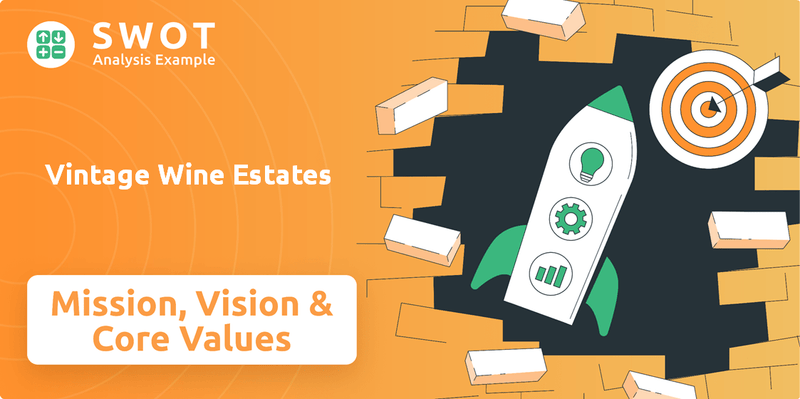
For investors and business strategists alike, knowing the Vintage Wine Estates mission statement, vision statement, and core values provides invaluable insight. These elements are not merely statements; they are the driving forces behind every decision, from product development to market expansion within this prominent wine company. By examining these principles, we gain a deeper understanding of VWE Company and its commitment to the future.
Key Takeaways
- Vintage Wine Estates emphasized quality wines and consumer reach through diverse channels.
- Acquisitions were a key part of Vintage Wine Estates' growth strategy, expanding their portfolio.
- Recent restructuring and asset sales followed a bankruptcy filing, impacting the company's structure.
- The core values of quality and consumer focus remain relevant for the divested brands.
- Success of the brands depends on aligning strategy with consumer preferences in a competitive market.
Mission: What is Vintage Wine Estates Mission Statement?
Vintage Wine Estates' mission is 'to produce consistent quality in our luxury and lifestyle wines that are expressive and complex while offering a breadth of portfolio to a large base of consumers.'
The VWE Company, a prominent player in the wine industry, defines its mission with a clear focus on quality and consumer reach. This mission statement serves as a cornerstone for its operations and strategic decisions. The company's commitment extends across various price points, from accessible lifestyle wines to premium luxury offerings, ensuring a diverse portfolio that caters to a wide range of consumer preferences. This is a critical aspect of their business model, allowing them to capture a significant share of the market.
The mission emphasizes the production of wines that are both expressive and complex. This reflects the company's dedication to crafting wines that offer a rich and enjoyable experience for consumers. This focus on quality is paramount in the competitive wine market, differentiating VWE from its competitors.
The mission targets a large base of consumers, highlighting the company's strategy to appeal to a wide audience. This is achieved through a diverse portfolio that includes wines at various price points, from $10 to $150 per bottle. This strategy helps VWE to mitigate risk and capture a larger share of the overall wine market.
VWE's mission encompasses both luxury and lifestyle wine segments. This dual approach allows the company to cater to different consumer preferences and purchasing behaviors. The 'super premium to luxury segments' have been a key focus, benefiting from the ongoing 'premiumization trend' in the wine industry.
The company leverages its team of experienced winemakers and utilizes both heritage and cutting-edge technology. This combination ensures the consistent production of high-quality wines. This blend of tradition and innovation is crucial for maintaining a competitive edge in the wine industry.
VWE employs an omni-channel sales strategy, reaching consumers through various channels, including estate wineries, retail, restaurants, and e-commerce. This approach ensures broad market access and caters to diverse consumer purchasing habits. This multi-channel strategy is essential for maximizing sales and brand visibility.
The mission is inherently customer-centric, aiming to meet consumer preferences across various channels. This focus on the consumer is critical for building brand loyalty and driving sales. VWE’s success is directly linked to its ability to understand and respond to consumer demand.
Understanding the company mission is crucial for investors, stakeholders, and anyone interested in the VWE Company. It provides insight into the company's strategic direction and its commitment to delivering value to its customers and shareholders. The core principles of Vintage Wine Estates, as reflected in its mission, are central to its operations and future growth. The mission statement is a key component of the Vintage Wine Estates mission statement and guides its actions in the market.
Vintage Wine Estates SWOT Analysis
- Complete SWOT Breakdown
- Fully Customizable
- Editable in Excel & Word
- Professional Formatting
- Investor-Ready Format
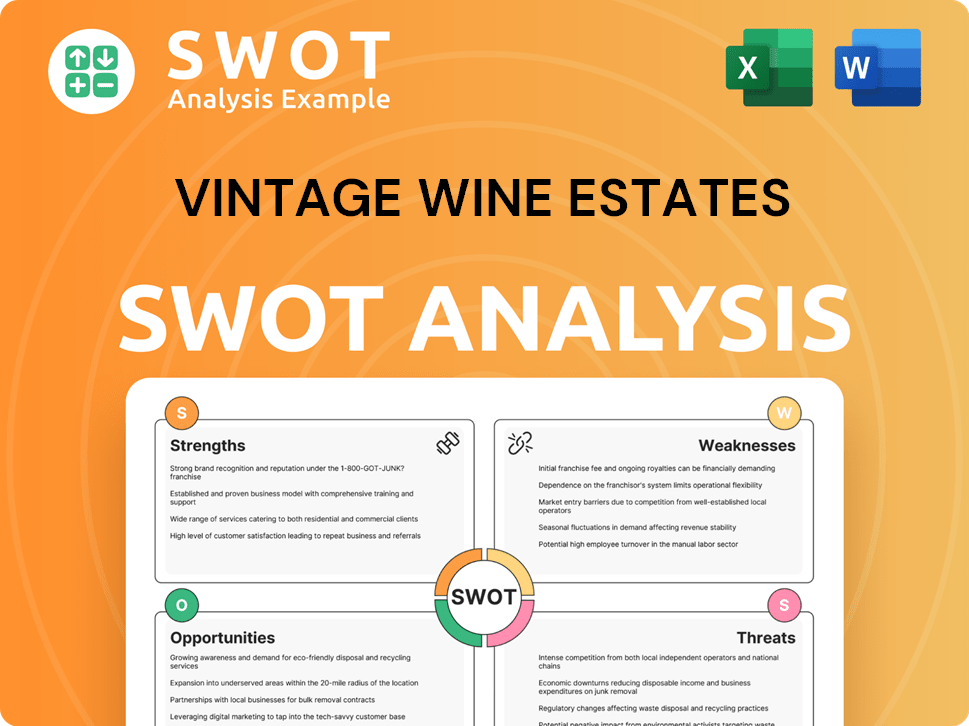
Vision: What is Vintage Wine Estates Vision Statement?
Vintage Wine Estates' (VWE Company) vision is "to be a growing, highly profitable omnichannel business with a consumer-centric culture."
Let's delve into the nuances of this vision statement.
The vision explicitly targets growth and high profitability. This indicates an ambition to expand market share and generate substantial financial returns. However, achieving this is currently challenged by the company's recent financial difficulties.
The "omnichannel" approach signifies a commitment to serving consumers across multiple sales channels – online, retail, and potentially direct-to-consumer experiences. This strategy aims to provide convenience and cater to diverse consumer preferences. The success of this strategy depends on effective integration and management of all channels.
A consumer-centric culture emphasizes understanding and meeting customer needs. This involves focusing on product quality, customer service, and building brand loyalty. This is critical for long-term success in the competitive wine market.
The path to achieving this vision is currently complicated. Vintage Wine Estates filed for Chapter 11 bankruptcy in July 2024. This necessitates restructuring, asset sales, and a focus on financial stability before significant growth and profitability can be realized. The company's ability to execute its vision is heavily dependent on its restructuring plan.
While the vision doesn't explicitly state a geographic focus, Vintage Wine Estates is primarily a U.S.-based wine company. The company's operations and brand portfolio are largely concentrated within the United States. Any expansion would likely start from this base.
To realize its vision, Vintage Wine Estates must prioritize operational efficiency, brand building, and effective channel management. This requires strategic decision-making in areas such as product development, marketing, and distribution. For more insights, you can explore the Marketing Strategy of Vintage Wine Estates.
Understanding the vision of Vintage Wine Estates (VWE Company) is crucial for assessing its future potential. While ambitious, the current financial situation presents significant hurdles. The company's ability to navigate these challenges and execute its strategic plan will determine its success in achieving its stated vision, impacting the company mission and core values.
Vintage Wine Estates PESTLE Analysis
- Covers All 6 PESTLE Categories
- No Research Needed – Save Hours of Work
- Built by Experts, Trusted by Consultants
- Instant Download, Ready to Use
- 100% Editable, Fully Customizable
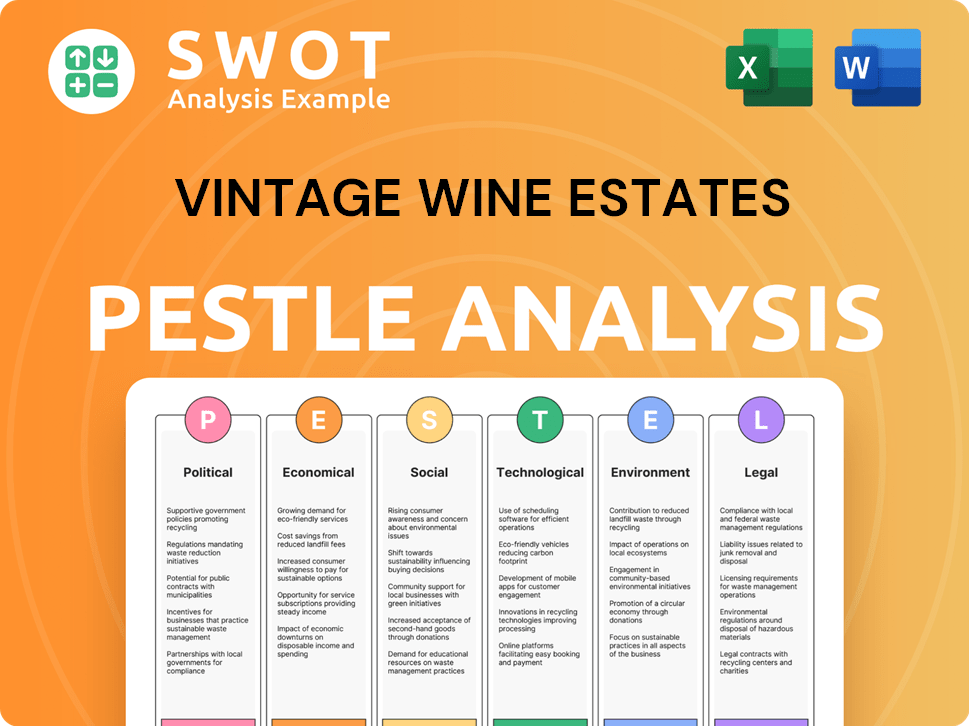
Values: What is Vintage Wine Estates Core Values Statement?
While a formal, enumerated list of core values for Vintage Wine Estates (VWE Company) isn't readily available in the search results, several key themes consistently emerge, offering valuable insights into their operational principles. These values guide the company's actions and shape its interactions with customers, partners, and the broader community.
Quality is a fundamental value for Vintage Wine Estates, as reflected in their mission to produce the "finest quality wines." This commitment is evident in their rigorous winemaking processes, the selection of premium grapes, and the focus on the characteristics of their luxury and lifestyle wines. This dedication to quality allows VWE to differentiate itself in the competitive wine market, aiming to provide a superior product across various price points.
Vintage Wine Estates places a strong emphasis on customer-centricity, which is reflected in both its mission and vision statements. This value is demonstrated through the company's efforts to provide "incredible customer experiences" at its wineries and across its sales channels. Furthermore, VWE's product development strategy is shaped by a desire to offer a diverse portfolio that caters to a wide range of consumer tastes and preferences. This focus is vital in a market where consumer preferences are constantly evolving, as highlighted in a recent report by the Wine Institute, which showed a 2.2% increase in U.S. wine consumption in 2023, underscoring the need to understand and cater to diverse consumer segments.
Innovation is a key strategic component for Vintage Wine Estates, as emphasized by President Terry Wheatley. This value drives the development and launch of new brands and the exploration of innovative approaches in winemaking and business operations. The wine industry is dynamic, and innovation helps the VWE Company stay competitive and relevant. The company's commitment to innovation is reflected in its investments in new technologies and its efforts to expand its product offerings, as highlighted in a recent earnings call where VWE discussed new product launches and market expansion strategies.
Vintage Wine Estates values the heritage and expertise associated with its acquired wineries. This is evident in the company's description as a "family of wineries and wines" committed to producing the finest quality wines. This value provides a foundation of tradition and quality that underpins their brand identity. The company's focus on heritage and expertise is also reflected in its marketing efforts, which often highlight the history and craftsmanship of its wineries. This focus on heritage also helps to build brand loyalty and differentiate VWE in the market. For further insights into the consumer base, you might find it helpful to explore the Target Market of Vintage Wine Estates.
These core values of Vintage Wine Estates, though not explicitly listed, collectively aim to differentiate the VWE Company by combining a commitment to quality and heritage with a consumer-focused and innovative approach to the wine business. Understanding these principles is crucial for anyone seeking to understand the strategic direction of this Wine company. The next chapter will delve into how these values, along with the mission and vision, influence the company's strategic decisions, providing a deeper understanding of its operational framework and future prospects.
How Mission & Vision Influence Vintage Wine Estates Business?
The mission and vision of Vintage Wine Estates (VWE Company) have profoundly shaped its strategic decisions, particularly in its approach to growth and market presence. These guiding principles have influenced key choices, from acquisitions to distribution channels, ultimately aiming to establish VWE as a leading player in the wine industry.
Vintage Wine Estates' (VWE) mission and vision have historically driven its aggressive acquisition strategy. This approach has been central to expanding its portfolio and market share. The company's focus on acquiring established wine brands and vineyards directly reflects its commitment to growth and diversification.
- Over two dozen acquisitions in the past decade demonstrate a clear strategic direction.
- Acquisitions aimed to broaden the range of wine offerings and reach different consumer segments.
- This strategy aligns with a vision of becoming a major player in the wine industry.
- The goal is to achieve economies of scale and increase overall profitability.
The company's vision of reaching consumers through multiple channels has led to investments in direct-to-consumer platforms and strategic partnerships. This strategy is designed to enhance accessibility and brand visibility. The acquisition of companies like Vinesse, LLC, exemplifies this commitment.
Initially, the acquisition-led growth strategy appeared successful, with revenue increasing to $294 million by the end of fiscal year 2022, a 33% increase. This growth phase indicated a positive impact from the company's strategic initiatives. However, recent financial results reveal challenges.
Recent financial performance, including revenue declines and significant net losses in fiscal year 2024, highlights the difficulties in executing the initial strategy. These challenges underscore the need for a reevaluation of the company's approach. The current market conditions and internal operational issues have created obstacles.
The historical actions of Vintage Wine Estates, such as acquisitions and channel diversification, were directly aligned with its mission to offer a broad portfolio and its vision of becoming a growing business. The company's strategic decisions were consistently geared towards achieving these goals. The long-term success of these actions remains to be seen.
The evolving market conditions and financial performance necessitate a degree of adaptability in Vintage Wine Estates' strategic approach. The company must be prepared to adjust its plans to ensure continued relevance and success. This includes potentially refining its mission and vision.
Future strategic decisions will likely need to consider factors such as market trends, consumer preferences, and operational efficiencies. The company's ability to adapt and innovate will be critical. For more insights, read about the Growth Strategy of Vintage Wine Estates.
The influence of the Vintage Wine Estates mission, vision, and core values on its strategic decisions is undeniable, shaping its growth trajectory and market positioning. However, the recent financial performance indicates a need for strategic adjustments to align with the company's long-term goals. Next, we'll delve into the core improvements needed for the company's mission and vision.
Vintage Wine Estates Business Model Canvas
- Complete 9-Block Business Model Canvas
- Effortlessly Communicate Your Business Strategy
- Investor-Ready BMC Format
- 100% Editable and Customizable
- Clear and Structured Layout
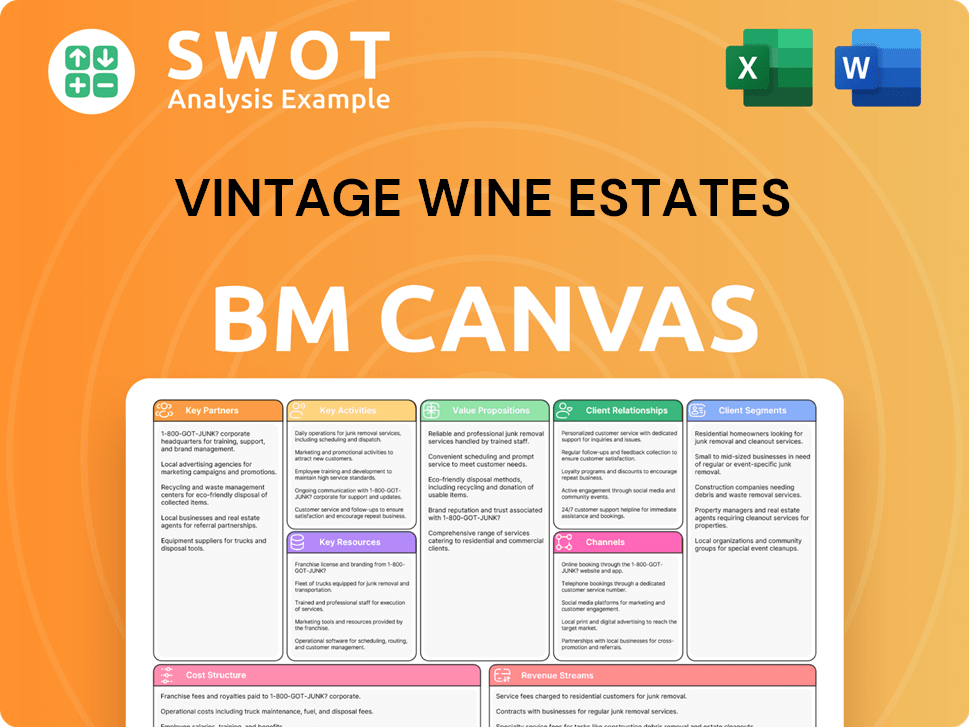
What Are Mission & Vision Improvements?
While Vintage Wine Estates (VWE Company) has established its Mission Vision Core Values, there's room for strategic enhancements to better reflect current industry trends and stakeholder expectations. These improvements are particularly relevant given the evolving landscape of the wine industry and the increasing importance of sustainability and social responsibility.
The company's mission should explicitly state a commitment to sustainable practices across all operations. This includes grape growing, winemaking, packaging, and distribution, aligning with the growing consumer demand for eco-friendly products. For example, the global sustainable wine market is projected to reach $8.3 billion by 2028, highlighting the financial benefits of such a commitment.
The vision statement should clearly articulate the company's commitment to ethical sourcing, fair labor practices, and community impact. This resonates with socially conscious consumers and investors, enhancing brand reputation and attracting talent. Data from the Wine Institute shows that consumers increasingly favor brands with strong ethical and sustainable practices, which can lead to higher brand loyalty.
The core values of Vintage Wine Estates should be updated to include environmental stewardship as a central tenet. This would demonstrate a tangible commitment to reducing the company's environmental footprint. The wine industry is facing increasing scrutiny regarding its carbon emissions, making this a crucial area for improvement.
Improve transparency by regularly reporting on sustainability initiatives and their impact. This can be achieved through detailed annual reports, showcasing progress toward sustainability goals and adherence to ethical standards. For context, a recent Brief History of Vintage Wine Estates provides context on the company's evolution and current standing, emphasizing the importance of adapting to market demands.
How Does Vintage Wine Estates Implement Corporate Strategy?
Implementation of a company's mission, vision, and core values is crucial for translating strategic intent into tangible actions and outcomes. This involves aligning operational practices, resource allocation, and stakeholder engagement with the organization's guiding principles.
Vintage Wine Estates (VWE Company) has historically implemented its mission and vision through acquisitions, direct-to-consumer initiatives, and customer-centric operations. However, recent financial challenges have significantly altered the company's strategic direction, impacting the execution of its long-term goals.
- Acquisition Strategy: VWE's growth strategy, a direct reflection of its mission to expand its portfolio, was primarily driven by acquiring other wine companies. This strategy aimed to increase market share and diversify its product offerings.
- Direct-to-Consumer (DTC) and Omnichannel Approach: The development of a DTC platform, tasting rooms, and wine clubs demonstrated a commitment to a customer-centric, omnichannel approach, aligning with a vision of providing exceptional customer experiences.
- Leadership's Role: Past leadership, including former CEO Pat Roney and President Terry Wheatley, actively reinforced the company's strategic direction. Roney emphasized growth, while Wheatley focused on innovation and acquisitions, thereby promoting the mission and vision.
- Communication to Stakeholders: The mission, vision, and core values were likely communicated through investor presentations, the company website, and internal communications, although the specifics of these communications are subject to change given the current restructuring.
The Chapter 11 bankruptcy filing in February 2024 and subsequent asset sales have significantly disrupted the implementation of Vintage Wine Estates' stated goals. The focus has shifted from growth and expansion to financial stabilization and debt reduction.
The alignment between stated values and actual business practices is currently under scrutiny. While the company previously emphasized customer-centricity and innovation, the current strategy prioritizes cost-cutting and asset monetization.
Formal programs or systems to ensure alignment with the mission and vision may have been in place, but the current financial situation has necessitated a shift in priorities. The focus is now on restructuring and simplifying operations.
The primary strategic priorities for Vintage Wine Estates now revolve around financial restructuring, including asset sales and debt reduction. The company aims to streamline its operations and improve its financial position.
Vintage Wine Estates Porter's Five Forces Analysis
- Covers All 5 Competitive Forces in Detail
- Structured for Consultants, Students, and Founders
- 100% Editable in Microsoft Word & Excel
- Instant Digital Download – Use Immediately
- Compatible with Mac & PC – Fully Unlocked
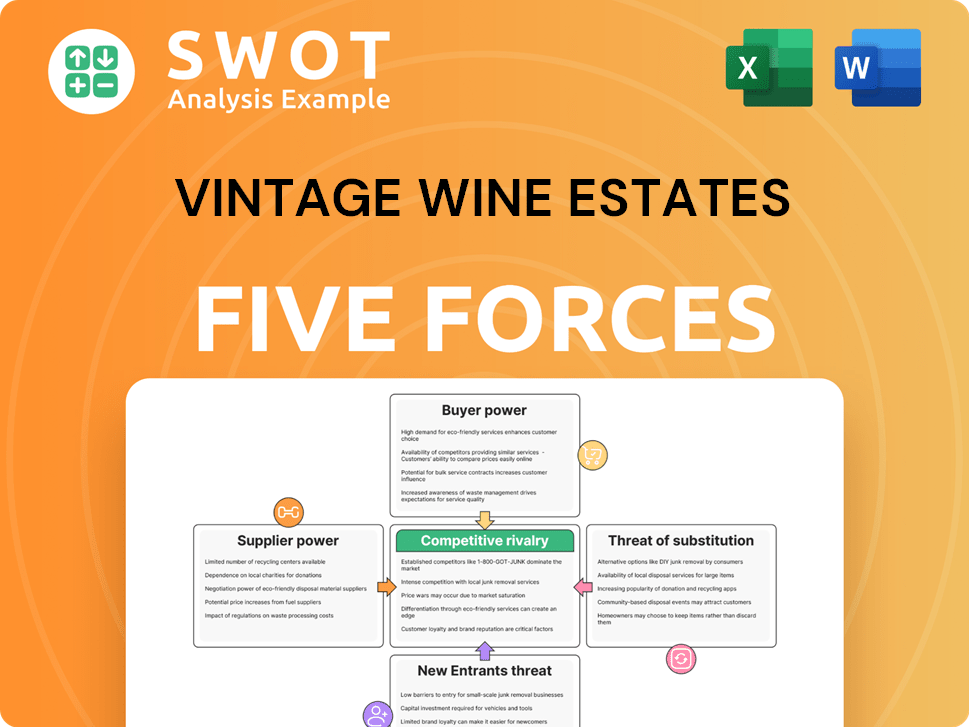
Related Blogs
- What are Mission Vision & Core Values of Vintage Wine Estates Company?
- What is Competitive Landscape of Vintage Wine Estates Company?
- What is Growth Strategy and Future Prospects of Vintage Wine Estates Company?
- How Does Vintage Wine Estates Company Work?
- What is Sales and Marketing Strategy of Vintage Wine Estates Company?
- Who Owns Vintage Wine Estates Company?
- What is Customer Demographics and Target Market of Vintage Wine Estates Company?
Disclaimer
All information, articles, and product details provided on this website are for general informational and educational purposes only. We do not claim any ownership over, nor do we intend to infringe upon, any trademarks, copyrights, logos, brand names, or other intellectual property mentioned or depicted on this site. Such intellectual property remains the property of its respective owners, and any references here are made solely for identification or informational purposes, without implying any affiliation, endorsement, or partnership.
We make no representations or warranties, express or implied, regarding the accuracy, completeness, or suitability of any content or products presented. Nothing on this website should be construed as legal, tax, investment, financial, medical, or other professional advice. In addition, no part of this site—including articles or product references—constitutes a solicitation, recommendation, endorsement, advertisement, or offer to buy or sell any securities, franchises, or other financial instruments, particularly in jurisdictions where such activity would be unlawful.
All content is of a general nature and may not address the specific circumstances of any individual or entity. It is not a substitute for professional advice or services. Any actions you take based on the information provided here are strictly at your own risk. You accept full responsibility for any decisions or outcomes arising from your use of this website and agree to release us from any liability in connection with your use of, or reliance upon, the content or products found herein.